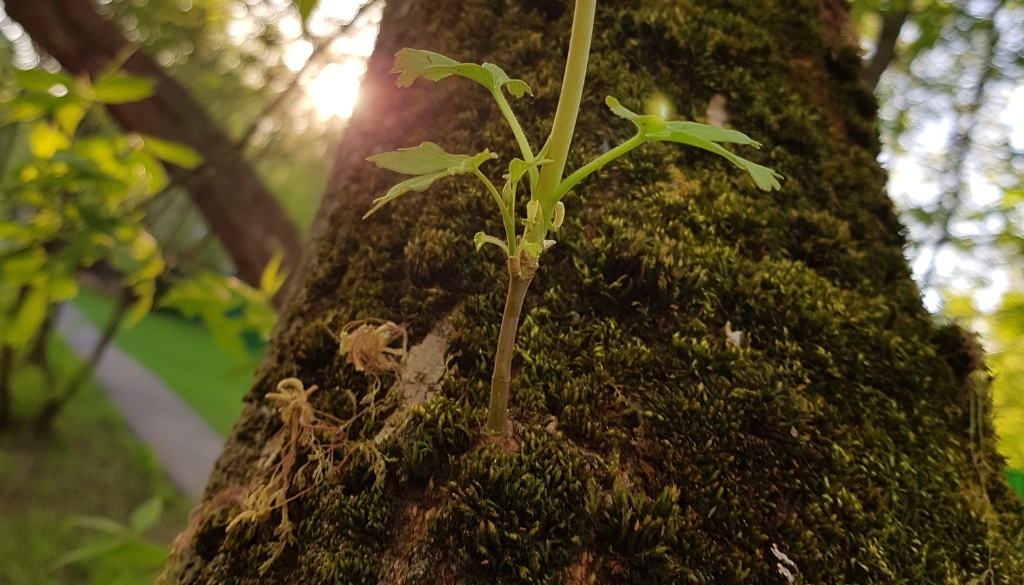Ever noticed sudden clusters of skinny branches shooting from the trunk or larger limbs of a tree? That’s probably what we know as epicormic shoots. Though these sprouts come out of nowhere and are believed to be thieves of your tree’s stored nutrients, the truth is more complicated. These shoots aren’t freeloaders, they’re actually a built-in survival mechanism.
What Are Epicormic Shoots?
Epicormic shoots, also called water sprouts, adventitious shoots, or sometimes “suckers”, are fast-growing stems that come out of dormant buds (undeveloped shoots, flowers, or leaves) beneath the bark. They usually grow straight upward and often appear in clusters, making them stand out from the tree’s more naturally placed branches.
The word sucker gives them a bad rap – as if they’re draining resources from the tree. But that’s the wrong way to go about them. They’re not some external threat looking specifically to feed off the tree’s energy; they’re the tree’s way of responding to stress or shock changes.

Why Do Epicormic Shoots Grow?
Trees are smarter and more self-sufficient than we give them credit for! Dormant buds exist under the bark as an emergency system, ready to jump into action when it senses something’s not quite right. Some reasons epicormic shoots pop up include:
- Stress recovery: After storms, damage, or heavy cutting, the tree produces shoots to quickly replace lost leaves and restore energy production. That’s why they grow to assist the tree when it’s absolutely necessary.
- Sudden light exposure: If a nearby tree is removed or a structure no longer blocks sunlight, the tree may sprout new growth to get a taste of light.
- Stored energy use: These shoots initially rely on carbohydrates the tree has stored. Once their own leaves develop, however, they begin producing food for themselves and even contribute to the tree’s overall energy supply.
- Genetics: Some species, like oak and linden, form epicormic shoots just because it’s in their blood.
So, epicormic growth isn’t a malfunction, it’s just your tree’s way of protecting itself against potential attacks. These suckers show up often on trees in counties like Nassau and Suffolk so, you’ll have to call for Long Island tree removal if these shoots do pose a threat.
Epicormic Growth vs. Normal Growth
Normal branches grow gradually and develop strong connections to the trunk or larger limbs. Epicormic shoots, in contrast, are more like emergency repairs. They form quickly and attach weakly, which makes them prone to breaking.
That said, their presence doesn’t mean the tree is failing or unable to heal itself. They serve as temporary “boosters” that help a tree recover after obstacles. An ash tree, for example, can rebuild an entire new crown thanks to epicormic growth. Without it, the tree wouldn’t survive.
Do I Need To Remove Epicormic Shoots?
Here’s where things often get thrown for a whirlwind. Many people assume epicormic shoots are “stealing” energy. Well, here’s the truth: early on, when they don’t yet have leaves, they do rely on stored energy, but that’s what those reserves are for. Once they develop leaves, they become self-sufficient and even contribute to the tree’s overall energy.
So no, they don’t “suck” life out of the tree. In fact, cutting them all off can sometimes harm the tree more than help it.
That said, there are times when leaving them unchecked isn’t good for the tree:
- Clusters can crowd the trunk, shading out stronger branches.
- Their weak attachment points can create safety risks if they snap in storms.
- Excessive growth can make the tree look unbalanced or messy.
Understanding the difference between natural and survival growth is the key here. That way you can tell the difference between if it needs immediate tree pruning or just a bit more love!

When Should I Remove an Epicormic Shoot?
Removal should always be about what’s best for the tree, not just appearance. Here are a few guidelines:
- While shoots are young: Small, soft shoots can often be snapped off by hand before they harden. This minimizes wounding.
- If they pose structural problems: Shoots that grow in spots where they’ll eventually rub against or compete with major limbs may pruning.
- When growth is excessive: If dozens of shoots are overwhelming the trunk or blocking light to healthy branches, selective thinning can help.
But remember: removing too many shoots robs the tree of photosynthetic area. In other words, cutting them all off is actually what drains energy, not the shoots themselves.
The Only Time You Should Be Concerned
Epicormic shoots themselves are not the issue. The real concern is why they’re appearing. Heavy growths of shoots can mean the following:
- Stress from improper cutting or over-thinning.
- Root damage from soil compaction or nearby construction.
- Pest or disease pressure.
- Environmental stress, such as drought, flooding, or sudden exposure to light.
Instead of focusing on simply “cleaning them out,” and “making your tree beautiful”, it’s better to ask: What is my tree trying to tell me? Does it need my assistance somewhere that I can’t see? A sudden burst of epicormic growth is often the tree waving a big red flag that something in its environment has changed, and it needs your care!

Don’t Shoot The Messenger
These suckers often get a bad reputation they don’t deserve. They aren’t parasites, and they’re not stealing from the tree – they’re the tree’s built-in survival tool. While some situations call for careful removal, treating them as “bad” by default overlooks the essential role they play in recovery and resilience.

